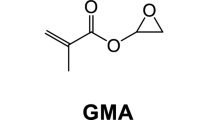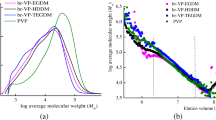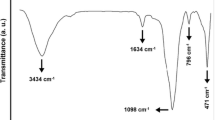Abstract
Mesoporous poly-divinylbenzenes prepared using very high dilution of monomers with porogenic solvent offer high surface area within relatively large pores. Their expanded morphology does not depend on nature of surrounding solvent, but during drying, it is prone to partial collapse due to the effect of capillary forces. This collapse is possible to diminish by post-polymerization crosslinking (hypercrosslinking) by Friedel–Crafts catalyzed reaction of residual vinyl groups remaining in the polymer after radical in their solvent-expanded state was evaluated using inverse steric exclusion chromatography polymerization. Effects of this hypercrosslinking were studied using two polymers prepared with monomer—porogenic solvent ratios 1:5 and 1:10. Morphologies of the examined polymers were examibed in their solvent-expanded state by inverse steric exclusion chromatography (ISEC) and in dry state by conventional nitrogen porosimetry. Evaluation of the dried hypercrosslinked polymers using conventional nitrogen porosimetry showing extremely high 70% porosity confirmed results of the swollen-state morphology assessment by the ISEC measurements.



Similar content being viewed by others
References
Guyot A, Synthesis and separations using functional polymers, in: Sherrington DC, Hodge P (ed.) Syntheses and separations using functional polymers Wiley, New York, 1988, pp. 1–4.
Okay O (2000) Macroporous copolymer networks. Prog Polym Sci 25:711–779
Gokmen MT, Du Perez FE (2012) Porous polymer particles—a comprehensive guide to synthesis, characterization, functionalization and applications. Prog Polym Sci 37:365–405
Smith DM, Scherer W, Anderson JM (1995) Shrinkage during drying of silica gel. J Non-Cryst Solids 188:191–206. https://doi.org/10.1016/0022-3093(95)00187-5
Sterchele S, Centomo P, Zecca M, Hanková L, Jeřábek K (2014) Dry- and swollen-state morphology of novel high surface area polymers. Micropor Mesopor Mater 185:26–29. https://doi.org/10.1016/j.micromeso.2013.10.005
Hanková L, Holub L, Xiangju M, Xiao FS, Jeřábek K (2014) Role of water as a coporogen in the synthesis of mesoporous poly(divinylbenzenes). J Appl Polym Sci 131:41198. https://doi.org/10.1002/app.41198
Hanková L, Holub L, Jeřábek K (2015) Formation of porous polymer morphology by microsyneresis during divinylbenzene polymerization. J Polym Sci B-Polym Phys 53:774–781. https://doi.org/10.1002/polb.23693
Ando K, Ito T, Teshima H (1988) Kusano H. In: Streat M (ed) Ion exchange for industry. Ellis Horwood Ltd., Chichester, pp 232–238
Aleksieva K, Xu J, Wang LM, Sassi A, Pientka Z, Zhang Z, Jeřábek K (2006) Effects of post-crosslinking of macroreticular styrene–divinylbenzene copolymers on their morphology. Polymer 47:6544–6550. https://doi.org/10.1016/j.polymer.2006.07.046
Tsyurupa MP, Davankov VA (2006) Porous structure of hypercrosslinked polystyrene: state-of-the-art mini-review. React Funct Polym 66:768–779. https://doi.org/10.1016/j.reactfunctpolym.2005.11.004
Jeřábek K, Hanková L, Holub L, Zecca M, Centomo P, Trovo D, Leder R, Biondi B (2018) Institute of Chemical Processes Fundamentals AS CR, Czech Republic; University of Padua, Italy. Eur Pat Appl 3: 546486.
Jeřábek K (1996) Inverse steric exclusion chromatography as a tool for morphology characterization. In: Potschka M, Dubin PL (eds) ACS symposium series 635. American Chemical Society, Washington, pp 211–225
Wieczorek PP, Kolarz BN, Galina H (1984) Porous structure of highly crosslinked styrene-divinylbenzene copolymers. Angew Makromol Chem 126:39–50. https://doi.org/10.1002/apmc.1984.051260105
Author information
Authors and Affiliations
Corresponding author
Additional information
Publisher's Note
Springer Nature remains neutral with regard to jurisdictional claims in published maps and institutional affiliations.
Rights and permissions
About this article
Cite this article
Soukupová, K., Jeřábek, K. Effect of post-polymerization crosslinking on morphology of mesoporous poly-divinylbenzene. Polym. Bull. 79, 10757–10764 (2022). https://doi.org/10.1007/s00289-021-04014-z
Received:
Revised:
Accepted:
Published:
Issue Date:
DOI: https://doi.org/10.1007/s00289-021-04014-z




